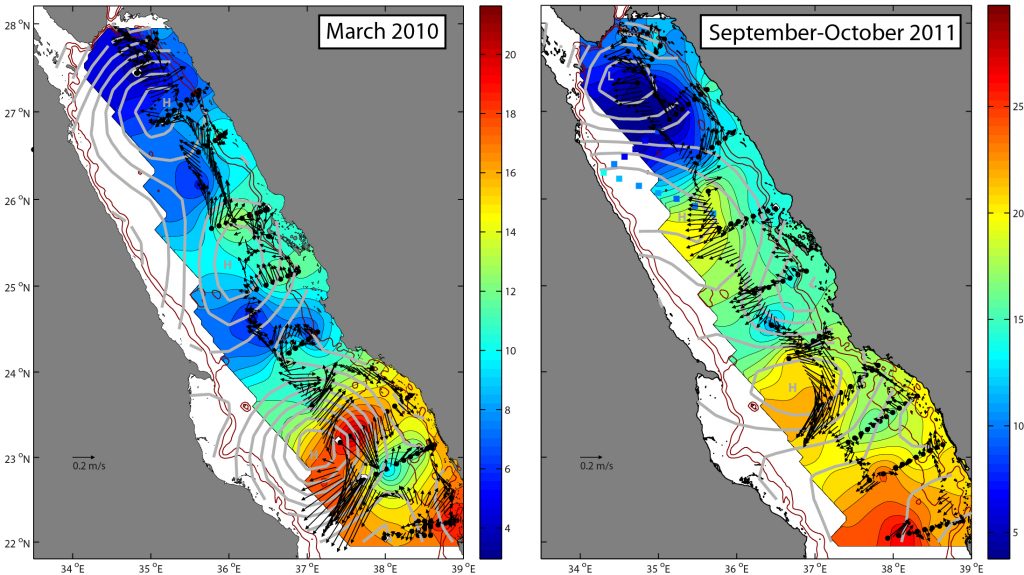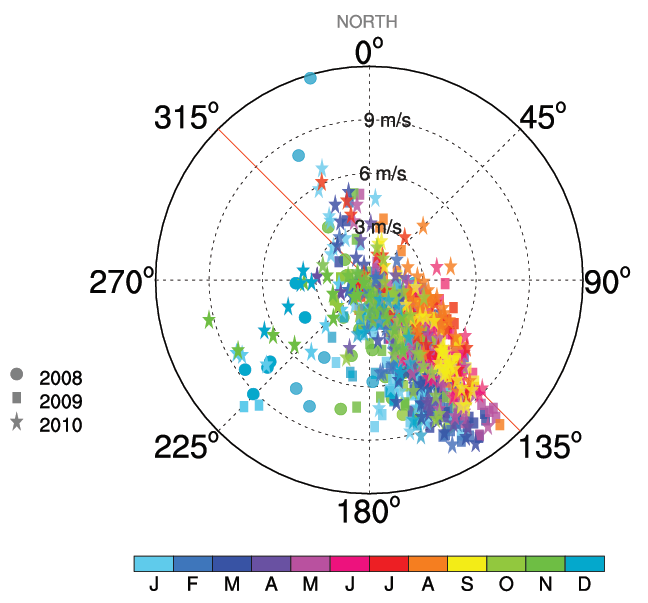Red Sea Circulation and Dynamics
 Overview: The Red Sea is arguably the most under sampled and least understood marginal sea in the World Ocean in terms of its circulation and dynamics. This is due in large part to the difficulty of obtaining in situ oceanographic and atmospheric observations in a region that has been largely off-limits for scientific research for decades. Earlier theoretical work focused on the two-dimensional overturning circulation, estimated to be on the order of 0.36 Sv. While this approach has been somewhat successful in reproducing the large-scale meridional density structure, it is of no use in understanding the more energetic (by an order of magnitude) boundary currents and eddies that appear in recent eddy-resolving ocean general circulation models of the Red Sea. These more realistic model simulations have not been validated against observations and do not agree on some of the most basic circulation features. Furthermore, as a primarily buoyancy-driven basin with large meridional extent (~2000 km) and narrow aspect ratio (~200 km width), the Red Sea is an interesting case for testing recent ideas about buoyancy-driven circulation in marginal seas
Overview: The Red Sea is arguably the most under sampled and least understood marginal sea in the World Ocean in terms of its circulation and dynamics. This is due in large part to the difficulty of obtaining in situ oceanographic and atmospheric observations in a region that has been largely off-limits for scientific research for decades. Earlier theoretical work focused on the two-dimensional overturning circulation, estimated to be on the order of 0.36 Sv. While this approach has been somewhat successful in reproducing the large-scale meridional density structure, it is of no use in understanding the more energetic (by an order of magnitude) boundary currents and eddies that appear in recent eddy-resolving ocean general circulation models of the Red Sea. These more realistic model simulations have not been validated against observations and do not agree on some of the most basic circulation features. Furthermore, as a primarily buoyancy-driven basin with large meridional extent (~2000 km) and narrow aspect ratio (~200 km width), the Red Sea is an interesting case for testing recent ideas about buoyancy-driven circulation in marginal seas

Intellectual Merit : The overall goal of the proposed research is to increase our understanding of Red Sea circulation and its governing dynamics, through the analysis of observations and model outpput, including (1) several new unique in situ data sets of currents, water properties and air-sea fluxes, (2) time series of satellite-derived sea surface temperature, sea level anomaly and scatterometer winds and (3) recently generated numerical model products from the Finite-Volume Community Ocean Model (FVCOM) as well as realistic and idealized configurations of the MIT General Circulation Model (GCM). The research will focus on the structure and dynamics of eastern boundary currents, the impact of narrow mountain-gap wind jets on surface circulation and air-sea fluxes, and the formation mechanism(s) of mesoscale eddies. We also propose to revisit the Phillips (1966) model in the context of an idealized numerical simulation to assess its suitability for describing the overturning circulation.
Broader Impacts : Results from other coral reef areas suggest that the large-scale circulation in the Red Sea has a significant impact on the health of the vast and mostly pristine coral reef ecosystems of the Red Sea, which face a myriad of natural and anthropogenic threats. As a major conduit for much of the fossil fuels shipped to the west from the Arabian/Persian Gulf, results from the proposed research will contribute to the development of ocean forecast models for predicting the spread of pollutants and mitigating their negative impacts. The work also involves collaboration with international partners at KAUST and support for a postdoctoral investigator.
Funding
This project is generously funded by the National Science Foundation.

Publications
Menezes, V.V., T. Farrar, A. Bower, 2019. Evaporative implications of dry-air outbreaks over the norther Red Sea. Journal of Geophysical Research--Atmospheres. 124, doi.org/10.1029/2018JD028853.
Menezes, V., J. T. Farrar, and A.S. Bower, 2017. Westward mountain-gap wind jets of the Northern Red Sea as seen by QuikSCAT. Remote Sensing Environ.,209, 677-699, https://doi.org/10.1016/j.rse.2018.02.075.
Bower, A.S., and J.T. Farrar, 2015. Air-sea interaction and horizontal circulation in the Red Sea. In: The Red Sea: The Formation, Morphology, and Environment of a Young Ocean Basin, N. Rasul and I. Stuart (eds); Springer Publishing, Germany.
Papadopoulos, V.P., S.S. Sofianos, D.E. Raitsos, A. Bower, P. Zhan, M. Qurban, Y. Abualnaja, H. Kontoyiannis, A. Pavlidou, N. Zarokanellos, and I. Hoteit, 2015. Factors governing the deep ventilation of the Red Sea. Journal of Geophysical Research - Oceans, 120, 7493-7505, doi: 10.1002/2015JC010996.
Zhai, P., L. Pratt, and A.S. Bower, 2015. On the crossover of boundary currents in an idealized model of the Red Sea. Journal of Physical Oceanography, 45(5), 1410-1425, doi: http://dx.doi.org/10.1175/JPO-D-14-0192.1
Zhai, P., A. Bower, W. Smethie, and L. Pratt, 2015. Formation and spreading of Red Sea outflow water in the Red Sea. Journal of Geophysical Research - Oceans, 120, 6542–6563, doi:10.1002/2015JC010751.
Churchill, J. H., A.S. Bower, D.C. McCorkle, and Y. Abualnaja, 2014. The transport of nutrient-rich Indian Ocean water through the Red Sea and into coral reef ecosystems. Journal of Marine Research, 72(3), 165-181.
Yao, F., I. Hoteit, L. J. Pratt, A. S. Bower, P. Zhai, A. Khöl and G. Gopalakrishnan, 2014. Seasonal overturning circulation in the Red Sea: 1. Model validation and summer recirculation. Journal of Geophysical Research, 119, 2238-2262, doi: 10.1002/2013JC009331.
Yao, F., I. Hoteit, L. J. Pratt, A. S. Bower, A. Köhl, G. Gopalakrishnan and D. Rivas, 2014. Seasonal overturning circulation in the Red Sea: 2. Winter circulation. Journal of Geophysical Research, 119, 2263-2289, doi:10.1002/2013JC009331.